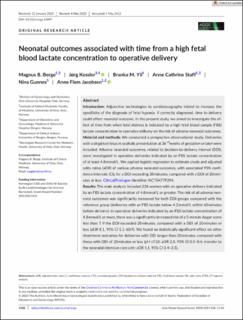| dc.contributor.author | Berge, Magnus Bollum | |
| dc.contributor.author | Kessler, Jørg | |
| dc.contributor.author | Yli, Branislava Markovic | |
| dc.contributor.author | Staff, Anne Cathrine | |
| dc.contributor.author | Gunnes, Nina | |
| dc.contributor.author | Jacobsen, Anne Flem | |
| dc.date.accessioned | 2023-10-30T14:39:21Z | |
| dc.date.available | 2023-10-30T14:39:21Z | |
| dc.date.created | 2023-06-23T13:02:58Z | |
| dc.date.issued | 2023 | |
| dc.identifier.issn | 0001-6349 | |
| dc.identifier.uri | https://hdl.handle.net/11250/3099503 | |
| dc.description.abstract | Introduction: Adjunctive technologies to cardiotocography intend to increase the specificity of the diagnosis of fetal hypoxia. If correctly diagnosed, time to delivery could affect neonatal outcome. In the present study, we aimed to investigate the effect of time from when fetal distress is indicated by a high fetal blood sample (FBS) lactate concentration to operative delivery on the risk of adverse neonatal outcomes.
Material and methods: We conducted a prospective observational study. Deliveries with a singleton fetus in cephalic presentation at 36+0weeks of gestation or later were included. Adverse neonatal outcomes, related to decision-to-delivery interval (DDI), were investigated in operative deliveries indicated by an FBS lactate concentration of at least 4.8 mmol/L. We applied logistic regression to estimate crude and adjusted odds ratios (aOR) of various adverse neonatal outcomes, with associated 95% confidence intervals (CI), for a DDI exceeding 20 minutes, compared with a DDI of 20 minutes or less. ClinicalTrials.gov Identifier: NCT04779294.
Results: The main analysis included 228 women with an operative delivery indicated by an FBS lactate concentration of 4.8 mmol/L or greater. The risk of all adverse neonatal outcomes was significantly increased for both DDI groups compared with the reference group (deliveries with an FBS lactate below 4.2 mmol/L within 60 minutes before delivery). In operative deliveries indicated by an FBS lactate concentration of 4.8 mmol/L or more, there was a significantly increased risk of a 5-minute Apgar score less than 7 if the DDI exceeded 20 minutes, compared with a DDI of 20 minutes or less (aOR 8.1, 95% CI 1.1–60.9). We found no statistically significant effect on other short-term outcomes for deliveries with DDI longer than 20 minutes, compared with those with DDI of 20 minutes or less (pH ≤7.10: aOR 2.0, 95% CI 0.5–8.4; transfer to the neonatal intensive care unit: aOR 1.1, 95% CI 0.4–3.5).
Conclusions: After a high FBS lactate measurement, the increased risk of adverse neonatal outcome is further augmented if the DDI exceeds 20 minutes. These findings give support to current Norwegian guidelines for intervention in cases of fetal distress. | en_US |
| dc.language.iso | eng | en_US |
| dc.publisher | Wiley | en_US |
| dc.rights | Navngivelse-Ikkekommersiell 4.0 Internasjonal | * |
| dc.rights.uri | http://creativecommons.org/licenses/by-nc/4.0/deed.no | * |
| dc.title | Neonatal outcomes associated with time from a high fetal blood lactate concentration to operative delivery | en_US |
| dc.type | Journal article | en_US |
| dc.type | Peer reviewed | en_US |
| dc.description.version | publishedVersion | en_US |
| dc.rights.holder | Copyright 2023 the authors | en_US |
| cristin.ispublished | true | |
| cristin.fulltext | original | |
| cristin.qualitycode | 1 | |
| dc.identifier.doi | 10.1111/aogs.14597 | |
| dc.identifier.cristin | 2157486 | |
| dc.source.journal | Acta Obstetricia et Gynecologica Scandinavica | en_US |
| dc.source.pagenumber | 1106-1114 | en_US |
| dc.identifier.citation | Acta Obstetricia et Gynecologica Scandinavica. 2023, 102 (8), 1106-1114. | en_US |
| dc.source.volume | 102 | en_US |
| dc.source.issue | 8 | en_US |

